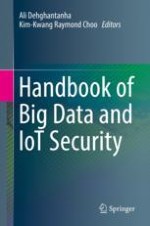2019 | OriginalPaper | Chapter
Evaluation and Application of Two Fuzzing Approaches for Security Testing of IoT Applications
Authors : Omar M. K. Alhawi, Alex Akinbi, Ali Dehghantanha
Published in: Handbook of Big Data and IoT Security
Publisher: Springer International Publishing
Activate our intelligent search to find suitable subject content or patents.
Select sections of text to find matching patents with Artificial Intelligence. powered by
Select sections of text to find additional relevant content using AI-assisted search. powered by
